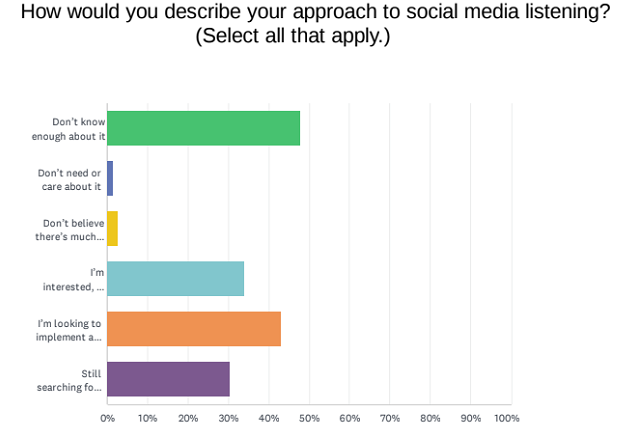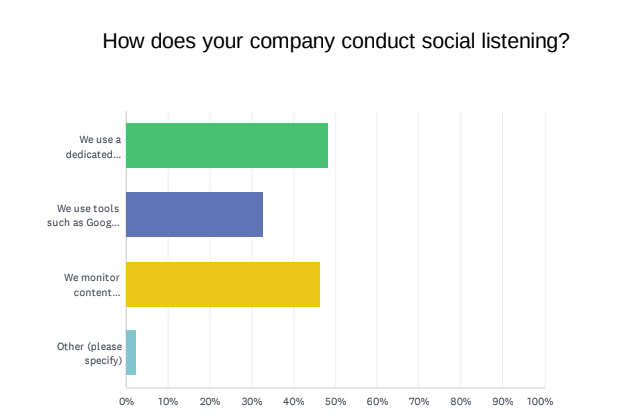How can you improve and refine your social media monitoring process, in order to maximize the value for your business?
That’s the final element we sought to establish based on the data we gleaned in our State of Social Listening 2022 report, conducted in partnership with Meltwater. We gathered feedback from more than 650 professionals, across a range of industries, in order to learn how marketers are benefiting from their social listening program, and how they’re translating their listening insights within their strategic communications process.
This final summary is part of our larger State of Social Listening report, which you can download in full here, while you can also check out part one, two and three of our report summaries as well.
Part IV: Building a Better Social Listening Strategy
So what are the key takeaways from our 2022 social listening report?
It’s clear that most businesses now see the value of tuning into social media conversations, and that those that do are gleaning significant benefits. But the actual process remains challenging for many.
Indeed, the responses indicate that many businesses don’t feel that they’re getting the most out of their listening effort, purely because they don’t have the expertise available to fully capitalize on their opportunities.

Some of that can be solved by smarter apps and tools designed to simplify the process. Twitter, for example, is working on new advanced search monitoring tools in TweetDeck, its native monitoring dashboard, which make it easier to understand the various parameters available, while various apps have been working to provide similar, enabling faster set-up and better mention filtering.
But none of these solutions are perfect, and it’s almost impossible for automated tools to cram in years of knowledge of Boolean search strings to ensure that you’re getting the most out of your monitoring effort, in the most efficient way.
Which is really the key. For years, even before the social media era, media monitoring services have relied on experts in Boolean strings to provide their clients with only the most relevant alerts, and with many of them paying per alert, they’ve essentially had to build the most efficient monitoring systems to ensure customer satisfaction.
But they’re complex, and require thorough investigation and questioning. For example, did you know that you can filter your Twitter search results by specific region or city? Using the ‘near’ or ‘geocode’ search operands will filter your results by location, which are just two of the more than 30 qualifiers you can add to a Twitter search to hone in your results.
Here’s an example in action:
pizza near:Washington within:15mi -“Pizza Hut”
Using this search string would give me a listing of all references to pizza, excluding Pizza Hut, in the Washington DC area only. And that’s nowhere close to just how specific search strings can get, with Boolean elements available on most monitoring platforms.
Which likely suggests that you need to learn, and there are various courses available that teach more in-depth operands, while Google has its own set of search parameters that can also be helpful in filtering your results.
Or you need to partner with experts in the field to establish more clarified, qualified mentions relative to your business. Again, various third party apps do offer solutions on this front, and many will provide their own experts to help set-up your search terms – and the good news is that, quite often, you only need to set up your search strings once, with minimal refinements for your main terms from there.
Of course, there will be breaking events and issues that will impact your key terms, so building an underlying understanding, as best you’re able, will also help. But our response data here shows that most businesses are not confident that they’re maximizing their listening opportunities, yet even with that in mind, they are still seeing clear benefits from their own, basic initiatives and strategies.

More data is always better, and social listening may be one of the best, most effective ways to stay on top of industry trends, and build your business based on direct feedback and broader understanding of your specific market. Some brands and products will see more mentions than others, providing more insight, but there are ways for all businesses to glean valuable, actionable strategic insight from a refined social media monitoring program.
But you won’t know unless you look, and you won’t tap into all the insight available unless you broaden your thinking in regards to how people are discussing your brand and sector, what they truly want to know in their purchase process, and how to connect the dots between the various data points.
There are opportunities available, and they don’t necessarily require significant investment. But devoting the resources into learning, or working with those who have, will pay off over time.
You can download our full State of Social Listening Report, in partnership with Meltwater, here.



